Commercial Salmon Fisheries
Southeast Alaska & Yakutat Research: Alsek River Chinook Salmon Research
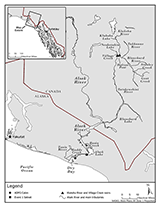
Figure 1. — Click for more Info
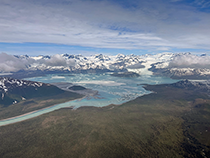
Figure 2. — Click for more Info
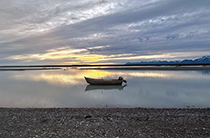
Figure 3. — Click for more Info
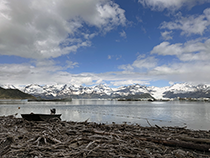
Figure 4. — Click for more Info
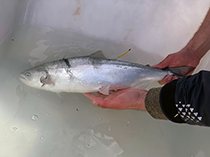
Figure 5. — Click for more Info
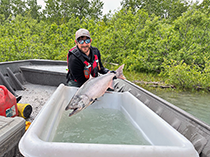
Figure 6. — Click for more Info
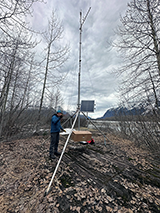
Figure 7. — Click for more Info
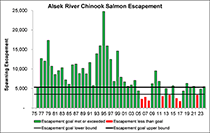
Figure 8. — Click for more Info
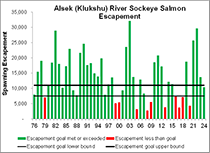
Figure 9. — Click for more Info
Overview
The Alsek River is a transboundary river originating in the Yukon Territory and British Columbia, Canada, and flows southerly into the Gulf of Alaska approximately 75 km southeast of Yakutat, Alaska (Figure 1). It is one of three transboundary rivers, along with the Taku and Stikine Rivers, that produce major runs of Chinook (Oncorhynchus tshawytscha) and sockeye (Oncorhynchus nerka) salmon jointly management by the Alaska Department of Fish and Game (ADF&G) and the Department of Fisheries and Oceans Canada (DFO), as outlined in Chapter 1 of the 2019 Pacific Salmon Treaty.
The Alsek River drainage covers about 28,000 km, but much of it, including the mainstem of the Alsek River, is inaccessible to anadromous salmonids due to velocity barriers. The largest tributaries are the Dezadeash and Tatshenshini Rivers. Significant spawning areas for Chinook salmon are found mostly in tributaries of the Tatshenshini River, including the Klukshu, Blanchard, and Takhanne Rivers and in headwater creeks in the upper Tatshenshini River. Significant spawning areas for sockeye salmon are the Klukshu, lower Tatshenshini, lower Alsek, Blanchard, and upper Tatshenshini Rivers and Klukshu, Blanchard, and Nesketahin Lakes (Figure 1). The Klukshu and upper Tatshenshini Rivers are accessible by road near Klukshu Village and Dalton Post, Yukon Territory.
Below the U.S./Canada border, the Alsek River flows 42 km into Alsek Lake. Large quantities of icebergs are present in the lake and are produced from calving events from the Alsek and Grand Plateau Glaciers (Figure 2). From the outlet of Alsek Lake, the river flows 31 km where it empties into the Gulf of Alaska at Dry Bay.
Chinook and sockeye salmon originating from the Alsek River drainage are harvested in the U.S. Dry Bay commercial, subsistence, and personal use fisheries in the lower portion of the Alsek River (Figure 3). In Canada, salmon are harvested in Champagne and Aishihik First Nations (CAFN) food fisheries and in recreational (sport) fisheries that largely occur in the Tatshenshini River and its tributaries. Inriver runs of Chinook and sockeye salmon have averaged about 8,000 and 95,000 fish, respectively, since the mid-1980s, and annual harvests averaged about 500 and 15,000 fish, respectively.
Adult Chinook and Sockeye Spawning Abundance
Since 1976, the principal escapement monitoring tool for Chinook and sockeye salmon stocks on the Alsek River has been the Klukshu River enumeration project, a project operated by DFO in cooperation with the CAFN. A weir (fence) was installed across the Klukshu River in 1976, and a large and annually variable proportion of the drainage-wide escapement of each species was enumerated every year through 2015. The weir was modified to a video enumeration system in 2016, allowing 24/7 unhindered passage of fish recorded by video with abundance tallied postseason. Escapements of sockeye salmon migrating to Nesketahin Lake were estimated annually from 1986 to 2013 using a weir across the lake outlet at Village Creek, located approximately 2 km upstream from its confluence with the Tatshenshini River. This weir was also modified to a video enumeration system beginning in 2014.
In 1997, ADF&G, in cooperation with DFO, instituted a project to determine the feasibility of using mark-recapture methods to estimate abundance of Chinook salmon in the Alsek River drainage. The results of the feasibility project were encouraging, and expanded mark-recapture studies were implemented to estimate the inriver abundance above Dry Bay from 1998 to 2004. Radiotelemetry studies were run to estimate spawning distribution in 1998 and 2002. The proportion of the total sockeye salmon escapement in the Alsek River system that is counted at the Klukshu River enumeration project had not been researched prior to 2000 except for a pilot study conducted in 1983. From 2001 to 2003, mark-recapture and radiotelemetry studies were conducted on Alsek River sockeye salmon to determine the inriver abundance above Dry Bay along with stock-specific run timing and spawning distribution.
The recent annex of the Pacific Salmon Treaty calls for the development and implementation of cooperative abundance-based management programs for Alsek River Chinook and sockeye salmon. This prompted ADF&G and DFO to reimplement mark-recapture studies on both species beginning in 2022 and efforts are ongoing. From May through August, adult Chinook and sockeye salmon are captured using set gillnets operated between river kilometer 19 and the outlet of Alsek Lake (Figure 4). Fish are then sampled for age, sex, and length as well as DNA in the form of a finclip for use in genetic analysis (Figures 5 and 6). In addition, as part of event 1 of the two-event mark-recapture study, all healthy fish are tagged with a spaghetti tag and also outfitted with a radio tag. Further upriver on the spawning grounds, as part of event 2 of the mark-recapture study, fish are enumerated past video weirs and visually analyzed for the presence of tags.
Combined, this information is used to estimate the inriver run of Chinook and sockeye salmon above Dry Bay, Alaska. After accounting for any inriver harvests above Dry Bay, escapement is then estimated. These inriver runs in addition to any harvests in Dry Bay equate to the total run for each species. A separate estimate of inriver abundance and escapement is also generated using genetic mark-recapture methods (gMR) that rely on the DNA gathered in Dry Bay and reliable counts and estimates of individual run components. The radiotelemetry study is designed to estimate the dropout rates and the fates of tagged Chinook and sockeye salmon. Radiotelemetry is also used to inform likely spawning locations throughout the Alsek River watershed. Every 1-2 weeks, from June through October, telemetry surveys using helicopters and fixed-wing aircraft are flown from the U.S./Canada border down to Dry Bay, and from above the border up to Turnback Canyon on the Alsek River, and to the headwaters of the Tatshenshini. In addition to telemetry surveys, there are five stationary towers located throughout the watershed to detect radiotagged Chinook and sockeye salmon migrating to their spawning grounds (Figure 7). Sockeye salmon have also been observed spawning throughout the lower (U.S.) portion of the Alsek River; however, the abundance of that portion of the run is unknown.
Alsek River Chinook salmon escapements have averaged 4,300 fish and ranged 1,700 to 6,300 fish since 2014. Alsek River Chinook salmon have an escapement goal range of 3,500 to 5,300 fish with a management objective of 4,700 fish (Figure 8). This corresponds to a Klukshu River goal range of 800 to 1,200 fish with a management objective of 1,000 fish. Alsek River sockeye salmon have an escapement goal range of 24,000 to 33,500 fish with a management objective of 29,700 fish. This corresponds to a Klukshu River goal range of 7,500 to 11,000 fish with a management objective of 9,700 fish. The Klukshu River sockeye salmon run experienced a period of decline beginning in 2016, and escapements fell below the current Biological Escapement Goal (BEG) range of 7,500 to 11,000 sockeye salmon in 4 out of the last 5 years from 2016 to 2020. Since 2021, Klukshu River sockeye salmon have met or exceeded escapement goals (Figure 9). In years of sockeye salmon mark-recapture research (e.g., 2000–2004, 2022–2023), escapements averaged around 74,000 fish and ranged 30,000 to 134,000 fish.
Selected Publications
- Inriver abundance of Alsek River Chinook and Sockeye Salmon 2022 (PDF 1,540 kB)
- Run Reconstruction and Escapement Goals for Alsek River Sockeye Salmon (PDF 3,917 kB)
- Sockeye Salmon Stock Status and Escapement Goals in Southeast Alaska (PDF 1,458 kB)
- Abundance of the Chinook Salmon Escapement on the Alsek River in 2004 (PDF 566 kB)
- Abundance of the Chinook Salmon Escapement on the Alsek River in 2003 (PDF 661 kB)
- Abundance of the Chinook Salmon Escapement on the Alsek River, 2000 (PDF 382 kB)
- Biological Escapement Goal for Klukshu River System Sockeye Salmon (PDF 400 kB)
- Abundance and Distribution of the Chinook Salmon Escapement on the Alsek River, 1998 (PDF 746 kB)
